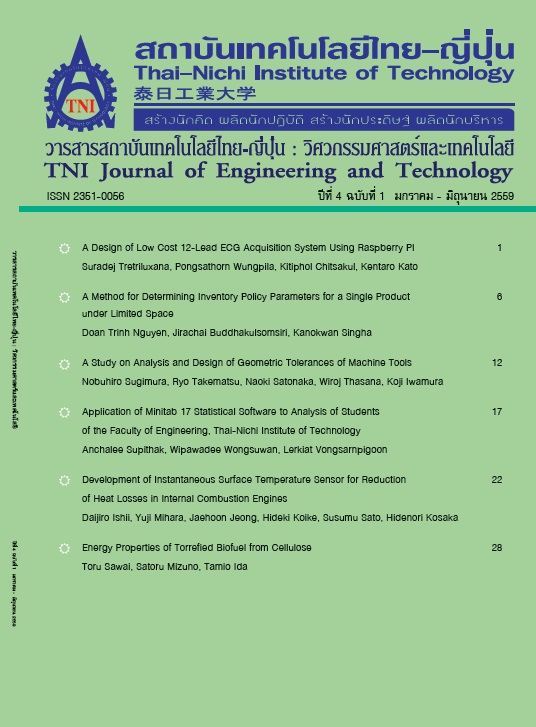Development of Instantaneous Surface Temperature Sensor for Reduction of Heat Losses in Internal Combustion Engines
Main Article Content
Abstract
In this research, thin-film temperature sensor (thin-film thermocouple) was directly formed on the surface of combustion chamber of a Rapid Compression and
Expansion Machine(RCEM) which imitated the internal combustion engines using a PVD (physical vapour deposition) method, and it aims at high accurate and high
response measurement of instantaneous temperature change from a compression stroke to a combustion start timing. In this paper, the newly developed structure and form of thinfilm thermocouple was described using one-dimensional numerical calculation in order to reduce the measurement error for real surface temperature. Moreover, the example measurement results of instantaneous temperature using RCEM were reported.
Article Details
Article Accepting Policy
The editorial board of Thai-Nichi Institute of Technology is pleased to receive articles from lecturers and experts in the fields of engineering and technology written in Thai or English. The academic work submitted for publication must not be published in any other publication before and must not be under consideration of other journal submissions. Therefore, those interested in participating in the dissemination of work and knowledge can submit their article to the editorial board for further submission to the screening committee to consider publishing in the journal. The articles that can be published include solely research articles. Interested persons can prepare their articles by reviewing recommendations for article authors.
Copyright infringement is solely the responsibility of the author(s) of the article. Articles that have been published must be screened and reviewed for quality from qualified experts approved by the editorial board.
The text that appears within each article published in this research journal is a personal opinion of each author, nothing related to Thai-Nichi Institute of Technology, and other faculty members in the institution in any way. Responsibilities and accuracy for the content of each article are owned by each author. If there is any mistake, each author will be responsible for his/her own article(s).
The editorial board reserves the right not to bring any content, views or comments of articles in the Journal of Thai-Nichi Institute of Technology to publish before receiving permission from the authorized author(s) in writing. The published work is the copyright of the Journal of Thai-Nichi Institute of Technology.
References
H. Kosaka, “Temperature Swing in Combustion Chamber Walls (1th Report),” in Proceeding of the Society of Automotive Engineers of Japan, Japan, 2012.
Y. Wakisaka, “‘Temperature Swing’ in Combustion Chamber Walls (2th Report),” in Proceeding of the Society of Automotive Engineers of Japan, Osaka, 2015.
M. Someya, Handbook of Thermal Transport Measurements Technology. n.p., 2011.
G. Woschni, “A Universally Applicable Equation for the Instantaneous Heat Transfer Coefficient in the Internal Combustion Engine,” in SAE Technical Paper 670931, 1967.
J. Tigira, Heat transfer calculation method. n.p., 1981.
Thermophysical properties handbook. Japan: Japan Society of Thermophysical Properties, 2008.
Y. Enomoto, T. Ohya, M. Ishii, K. Enomoto, and N. Kitahara, “Study on Analysis of Instantaneous Heat Flux Flowing into the Combustion Chamber Wall of an Internal Combustion Engine : Examination in the Case of Consideration of Heat Storage Term and the Temperature Dependency of the Thermocouple’s Thermophysical Properties,” JSME international journal, vol. 35, no. 4, pp. 608–615, 1992.
R. Arisawa, “Thermal Diffusivity Measurement of Insulator Oxide Films Using Thermoreflectance Method,” in The 28th Japan Symposium on Thermophysical Properties, Japan, 2007.
H. Kosaka, Y. Wakisaka, Y. Nomura, Y. Hotta, M. Koike, K. Nakakita, and A. Kawaguchi, “Concept of ‘Temperature Swing Heat Insulation’ in Combustion Chamber Walls and AppropriateThermo-Physical Properties for Heat Insulation Coat,” SAE International Journal of Engines, vol. 6, no. 1, pp. 142–149, Apr. 2013.


